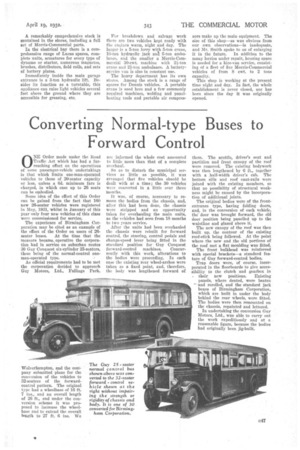Converting Normal-type Buses to Forward Control
Page 69

If you've noticed an error in this article please click here to report it so we can fix it.
ONE Order made under the Road Traffic Act which has had a farreaching effect on the operations of some passenger-vehiele undertakings is that which limits one-man-operated vehicles to those of 20-seater capacity or less, unless a 6d. minimum fare is charged, in which ease up to 26 seats can be embodied.
Some idea of the effect of this Order can be gained from the fact that 160 new 26-seater vehicles were registered in May. 1931, whilst in January of this year only four new vehicles of this class were commissioned for service.
The experience of Birmingham Corporation may be cited as an example of the effect of the Order on users of 26 seater buses. At the time that the measure became,. operative the corporation had in service on suburban routes 30 Guy Conquest six-cylinder 25-seaters, these being of the normal-control oneman-operated type.
As official requirements had to be met the corporation decided to approach Guy Motors, Ltd., Falliugs Park.
Wolverhampton, and the company submitted plans for the conversion of the vehicles to 32-seaters of the forwardcontrol pattern. The original type had a wheelbase of 1.6 ft. 7 ins., and an overall length of 26 ft., and under the conversion scheme it was proposed to increase the wheelbase and to extend the overall length to 27 ft. 6 ins. We are informed the whole cost amounted to little more than that of a complete overhaul.
S'o as to disturb the manicipal services as little as possible, it was arranged that five vehicles should be dealt with at a time; the 30 vehicles were converted in a little over three mon ths.
It was, of course, necessary to remove the bodies from the chassis, and, after this had been done, the chassis were stripped and an opportunity taken for overhauling the main units, as the vehicles had seen from 18 months to two years service.
sifter the units had been overhauled the chassis were rebuilt for forward control, the steering, control pedals and change-speed lever being fitted in the standard position for Guy Conquest forward-control machines. Concurrently with this works alterations to the bodies were proceeding. In each ease the existing rear wheel-arches were taken as a fixed point, and, therefore, the body was lengthened forward of them. The scuttle, driver's seat and partition and front canopy of the roof were removed. The existing bodywork was then lengthened by 6 ft., together with a .half-width driver's cab. The bottom sills and roof cant-rails were joined with the existing members, so that no possibility of structural weakness might be caused by the incorporation of additional joints.
The original bodies were of the frontentrance type, having folding doors, and, in the conversion of each vehicle, the door was brought forward, the old door position being panelled up to the waistline and glazed above it.
The new canopy of the roof was then built up, the contour of the existing roof-stick being followed. At the point where the new and the old portions of the roof met a flat moulding was fitted.
The front bulkhead was reinforced with special brackets—a standard fn. ture of Guy forward-control bodies.
Trap doors were, of course, incorporated in the floorboards to give accessibility to the clutch and gearbox in their new positions. Existing
panels, where dented, were beaten -.and rerolled, and the standard jack boxes of Birmingham Corporation, which are built in under the body behind the rear wheels, were fitted. The bodies were then remounted on the chassis, repainted and lettered.
In undertaking the conversion Guy Motors, Ltd., was able to carry out the work expeditiously and at a reasonable figure, because the bodies had originally been jig-built.












































































































